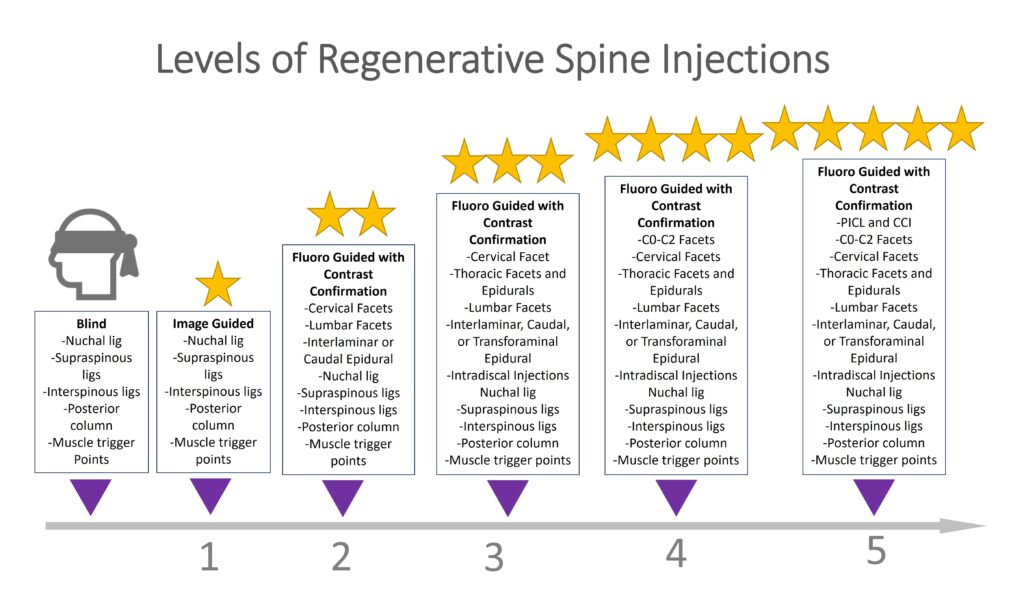Avoiding the Smolex: Understanding the Levels of Spinal Regen Med

Credit: Shutterstock
I’ve been spending a little time perusing Facebook groups to understand what patients believe and are exposed to daily. As an expert in this area, one of the conclusions is that spine regen med scams are rampant. Today we’ll dive into that problem by helping you learn about the vast difference in provider skill levels in spine injections by learning about Smolexes. Let’s dig in.
The Smolex
I grew up a middle-class kid in the blingy South Florida of the 80s. Miami Vice was in full swing, and every kid wanted a gold Rolex like the one Don Johnson wore on the show. However, no amount of busing tables or fixing bikes could have me afford that watch as my folks struggled to keep a roof over the heads of seven children, so a Rolex was unobtainable.
However, one day, while at the local “Swap Shop” (an open-air market at a drive-in theater), my brothers and I happened on a guy selling fake Rolexes for $30. From a distance, they looked real, so they sold well to people who wanted to look rich. Eventually, the market was flooded with these cheap Chinese watches and because they only worked for about a month, we soon coined the term “Smolex.” By the time I went to college, you could get a passable Smolex for about $20.
Smolexes and Regen Med
Because regenerative medicine is so complex, patients often buy a Smolex instead of the real thing. The difference is that they don’t know they’re buying a Smolex, so they often pay Rolex prices. That happens in many different ways, from purchasing a procedure using dead umbilical cord or amniotic cells to not getting the spine procedure they thought they bought. Today we’ll focus on the spine injection Smolex.
Levels of Spine Injection Procedures

The biggest thing that causes patients to purchase a Smolex spine injection is the vast difference in provider skill and training in spine injections and a patient misconception of parity in training among doctors in this space. For example, most patients believe that all physicians are trained the same and that a PRP or “stem cell” injection is the same wherever they go, just like a Starbucks Latte is the same in Seattle or Miami. However, in reality, what gets injected at a clinic in Seattle is often vastly different from what gets injected in a clinic in Miami or even across town.
To help you understand this topic, I have listed six spinal injection sophistication levels from 0 to 5. Most patients get the less sophisticated injections to the left but believe they actually got the more sophisticated injections to the right. Hence, they are paying top dollar for Smolex injections. To understand that, let’s see what can cause pain in the spine.
Here’s a list of all of the common things that can cause pain in your spine:
- Muscles and tendons
- Lax ligaments and/or atrophied muscles that cause instability
- Facet joints
- Irritated spinal nerves
- Disc injuries
If you look at the levels of spine injections above, here’s how these procedures line up with injecting various areas causing pain:
- Muscles and tendons-Levels 0-1
- Low back or neck facet joints-Level 2 and above
- Low back or neck irritated nerves-Levels 2 and above
- Low back or neck discs-Levels 3 and above
- Upper back (thoracic) facets or irritated nerves-Levels 3 and above
- Upper neck facet joints-Level 4 and above
- Most types of craniocervical instability (CCI)-Level 5
How common are these lower-level injections in regen med clinics? I estimate that 90% of what patients are currently offered are these basic level 0-1 level procedures that don’t treat most areas that can cause spine pain.
They Told Me the Cells Would Go Where They Are Needed
I often hear from patients who get these simple muscle and ligament injections that the clinic told them these cells would migrate to the disc, facet joint, or nerves. The problem is that we have zero evidence that this happens. For example, the disc is largely avascular, meaning it has no or a very poor blood supply. So even if a cell hitched a ride in a blood vessel and knew where to go, it couldn’t get to the injured part of the disc.
Why do clinics often sell procedures this way? Because hiring physicians who have this more sophisticated training is very expensive and hard to do. In addition, these more highly trained and specialized providers in many countries are very rare or non-existent. For example, these highly skilled providers are almost exclusively located in the U.S., parts of Europe, and Australia. They are very uncommon in Latin America or Asia.
Why Do These Lower-Level Spine Injections Sometimes Seem to Work?
I’ve seen some patients who got level 0 or 1 fake umbilical cord stem cell injections in the spine who report good results on Facebook. This makes sense as these products, like PRP, have growth factors, and some patients will respond if all you do is inject the muscles and ligaments. However, these same patients often could have been successfully treated with cheaper platelet-rich plasma injections for a fraction of the price they paid. So even the successes are getting ripped off.
It should also be noted that this injection strategy usually produces shorter-term results than the most sophisticated procedures.
How Can You Avoid Buying a Smolex at Rolex Prices?
When I bought Smolexes as a kid, I knew I was getting a fake. Most patients I talk to have no idea they’re getting a Smolex because they’re paying real Rolex prices for these lower-level procedures. Here are five things that should help you spot a Smolex:
- Most clinics that offer prolotherapy injections tend only to be able to perform the simple level 0 or 1 injections.
- Clinics using the term “facet capsule injections” usually perform the lower level 0/1 injections.
- While it’s possible that some of these injections, like facets and epidurals, can be done with ultrasound, in my experience, these injections are less accurate when performed that way. Hence the clinics that perform the higher level procedures use fluoroscopy (live X-ray guidance).
- Orthopedic or neurosurgeons generally aren’t trained in interventional spine. While there are very rare exceptions, if this is who is performing the injection, that’s a red flag. These procedures are usually performed by physical medicine and anesthesiology providers with fellowship training in interventional spine.
- There are a few clinics using fluoroscopy that only perform level 0/1 injections. They seem to be using it as a way to fool consumers. The key question here to ask is if they use contrast confirmation. That means the clinic injects radiographic contrast first to determine if there is flow of the injectate to the right spot before injecting the orthobiologic.
The upshot? Don’t buy a Smolex at Rolex prices. Clinics can get away with this because 99% of patients don’t know the difference. Now you know!

If you have questions or comments about this blog post, please email us at [email protected]
NOTE: This blog post provides general information to help the reader better understand regenerative medicine, musculoskeletal health, and related subjects. All content provided in this blog, website, or any linked materials, including text, graphics, images, patient profiles, outcomes, and information, are not intended and should not be considered or used as a substitute for medical advice, diagnosis, or treatment. Please always consult with a professional and certified healthcare provider to discuss if a treatment is right for you.
